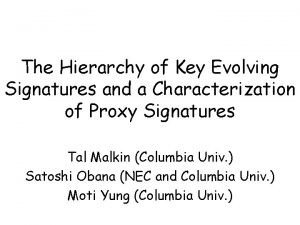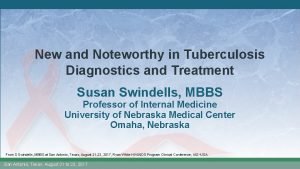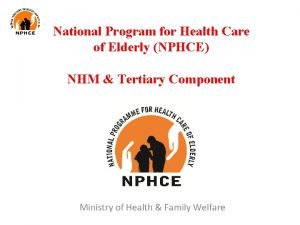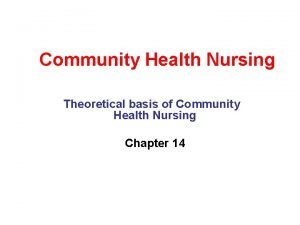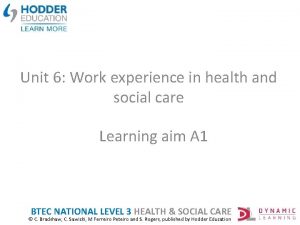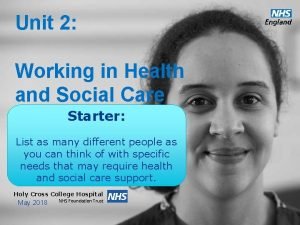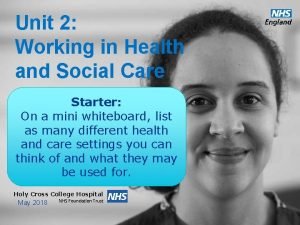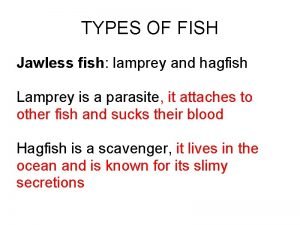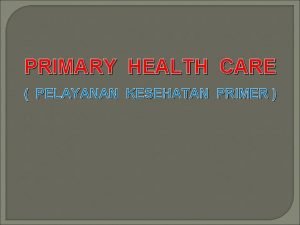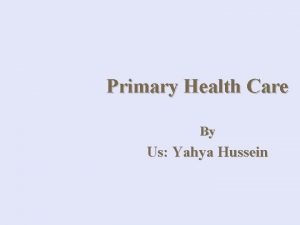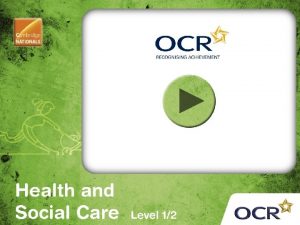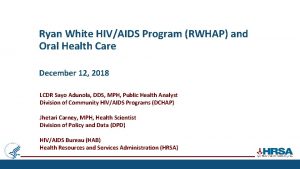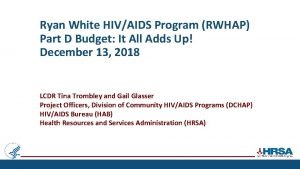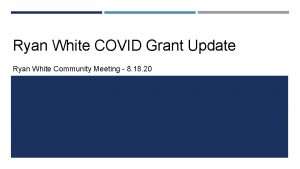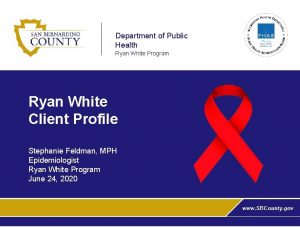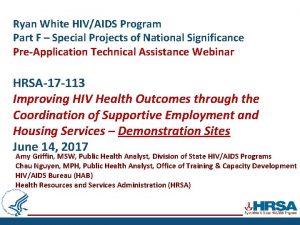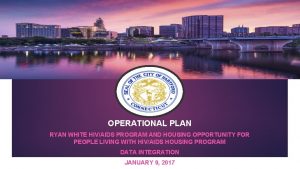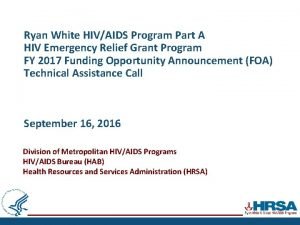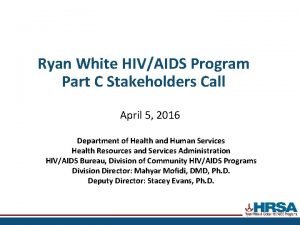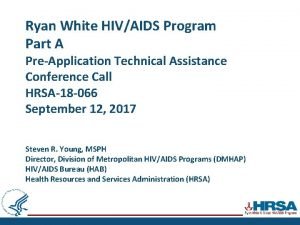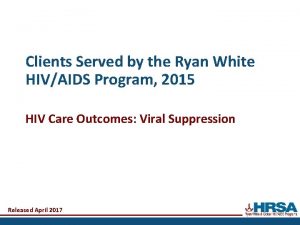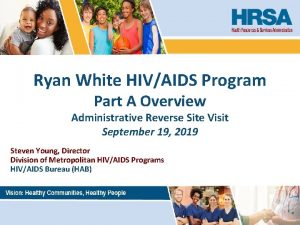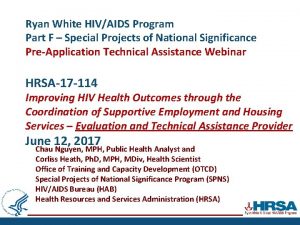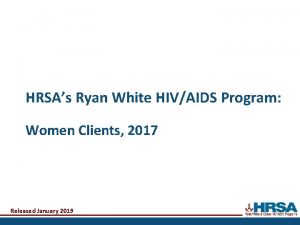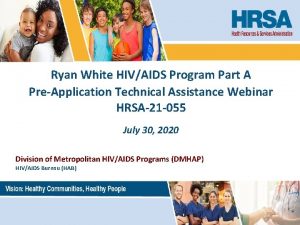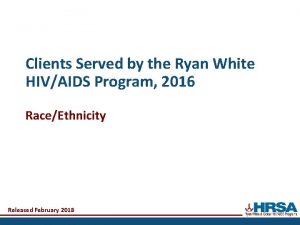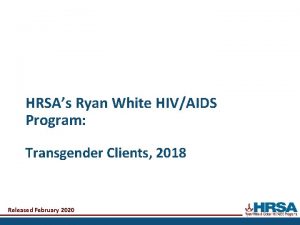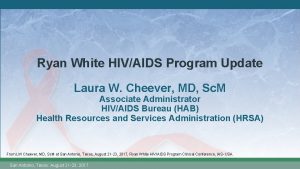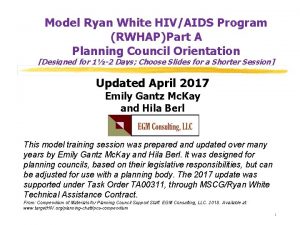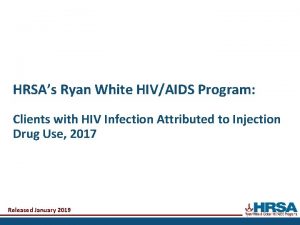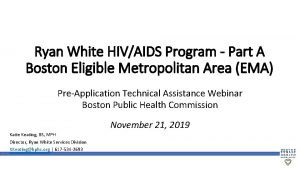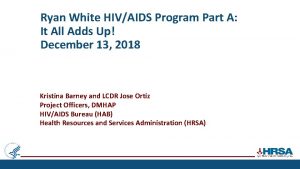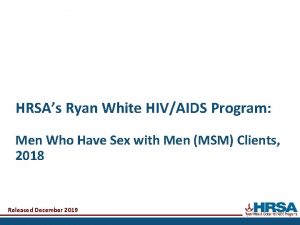Ryan White HIVAIDS Program RWHAP Evolving Health Care










































- Slides: 42

Ryan White HIV/AIDS Program (RWHAP) + Evolving Health Care Landscape = Results USCA - September 15, 2016

Speakers Antigone Dempsey, MEd Division Director, Division of Policy and Data HRSA HIV/AIDS Bureau Michael Costa, MPH Principal Associate Abt Associates 2

What We Will Cover Today 11: 15 -12: 00 pm Overview: RWHAP & Health Care Landscape 12: 00 -12: 15 pm RWHAP Studies 12: 15 -1: 15 pm Panel Q/A 1: 15 -1: 30 pm Closing Comments 3

Overview: RWHAP and the Health Care Landscape 4

RWHAP Moving Forward • Public health approach to provide a comprehensive system of care • Ensure low-income people living with HIV (PLWH) receive optimal care and treatment 5

RWHAP and the Evolving Health Care Landscape • The RWHAP is the payor of last resort for services not covered or not fully covered by other forms of health care coverage • The evolving health care landscape changed health care coverage options for many RWHAP clients 6

HIV/AIDS Bureau Priorities and the Evolving Health Care Landscape • NHAS 2020/PEPFAR 3. 0 - Maximize HRSA HAB expertise and resources to operationalize NHAS 2020 and PEPFAR 3. 0 • Leadership - Enhance and lead national and international HIV care and treatment through evidence-informed innovations, policy development, health workforce development, and program implementation • Partnerships - Enhance and develop strategic domestic and international partnerships internally and externally • Integration - Integrate HIV prevention, care, and treatment in an evolving healthcare environment • Data Utilization - Use data from program reporting systems, surveillance, modeling, and other programs, as well as results from evaluation and special projects efforts to target, prioritize, and improve policies, programs, and service delivery • Operations - Strengthen HAB administrative and programmatic processes through Bureau-wide knowledge management, innovation, and collaboration 7

Integrating with the Health Care Delivery System - Highlights • Engaging in Marketplace Insurance Plans Train RWHAP providers of core medical services to contract with qualified health plans o Facilitate client enrollment into health plans as appropriate • Establishing AIDS Service Organization (ASO) Service Models o Train non-medical ASOs to develop business plans to provide services for vulnerable populations o Improve health outcomes across the care continuum • Ryan White HIV/AIDS Program Outcomes within the Context of the Affordable Care Act o Assess effect of services offered post ACA implementation o Develop TA tools to assist recipients navigate insurance marketplace 8

Impact of Health Care System Changes on RWHAP Clients Data Demographics Studies 9

Ryan White HIV/AIDS Program Clients (non-ADAP), by Health Care Coverage, 2014—United States and 3 Territories 10

Select Demographics of RWHAP Clients, 2014 In 2014, 54% of HIV-positive RWHAP clients were served in Medicaid expansion states, 46% in non-Medicaid expansion states Medicaid Expansion States (n=257, 029) Non-Medicaid Expansion States (n=245, 361) Black/African American 42% 53% Hispanic/Latino 25% 19% White 29% 25% <100% Federal Poverty Level 61% 67% 11

Health Care Coverage Among HIVPositive RWHAP Clients, 2012– 2014 50 Health care coverage, % 45 40 35 30 25 33, 3 33, 1 27, 9 28, 0 13, 2 12, 5 11, 7 2012 2013 2014 33, 0 25, 4 20 15 10 5 0 Medicaid/Other Public 12 Uninsured Private

Health Care Coverage, by Medicaid Expansion Status, 2012– 2014 50 Medicaid Expansion States 50 45 45 Health care coverage, % 40 35 41, 8 37, 9 38, 0 40 35 30 30 25 25 23, 1 20 15 Non-Medicaid Expansion States 13, 8 10 22, 3 17, 0 12, 6 10, 9 34, 6 33, 3 28, 1 34, 5 27, 6 23, 9 20 15 10 5 12, 4 12, 5 2012 2013 2014 5 0 2012 2013 2014 Medicaid/Other Public 0 Uninsured Private

RWHAP ACA Studies Special Study-Emerging Issues Related to ACA Implementation. The Future of Ryan White Services: A Snapshot of Outpatient Ambulatory Medical Care (2015) RWHAP Outcomes within the Context of the Affordable Care Act (2015 -2017) 14

Acknowledgments • Robert Mills, Ph. D. • Antigone Dempsey, MEd. • HAB Advisory Group • All of the participating RWHAP site staff 15

Study Purpose • To assess: • the current status of Ryan White services during the early and later stages of ACA implementation; • how well the RWHAP is positioned to improve clinical outcomes, including viral suppression, retention to care, and linkage to care services; and, • the efforts of RWHAP providers to adapt to the implementation of the ACA • Collect information on service provision, quality of care, barriers, gaps, and challenges related to ACA implementation in 2014. 16

Abt Associates Review of Study Methodology Results 17

Mixed Methods Design • Qualitative Analyses: § 2 sets of Interviews with 30 RWHAP sites: June – July 2014 and February – March 2015. § Grant application narratives. § State Insurance Department info re: Qualified Health Plans (QHP) Benchmark and Medicaid Alternative Benefit Plans. • Quantitative Analyses: § 2013 and 2014 RSR client-level data (preliminary). o ~44, 000 cases/yr. § Interview data (events – counts/duration) 18

Site Sample Criteria Site Selection Medicaid expansion 10 expansion states/ 5 non-expansion states Prevalence 1/3 of sites are high, mid or low prevalence (4=ECHPP “ 12 Cities”) Population density Metropolitan, micropolitan, and rural # and types of RWHAP services 1 – 21 services 23 serve > 50% OAMC clients / 7 serve < 50% OAMC clients Numbers of clients served 116 – 4, 286 Part funding 92% have Parts A and/or B funding 33% have Parts C and/or D funding 26% have a funding from both of the above categories 19

Overall Conclusions • RWHAP funding continues to be critical to ensure the care necessary to fill gaps in essential services for clients. • There is a divergence of experience between expansion and nonexpansion states that will likely continue. • RWHAP sites are successfully adapting to ACA, but challenges remain. • Some RWHAP clients experienced fragmentation of care due to RWHAP sites’ lack of contracts with new insurers. • Sites added additional insurance enrollment/billing staff. • Fewer clients received OAMC services in expansion states after ACA implementation. § However, we cannot statistically distinguish this reduction from an overall downward trend in all states. 20

Q/A for the Panel 21

Question 1 How have RWHAP clinics adapted to the changing health care environment? 22

Leveraging of New Health Care Landscape • Cost Savings. Some sites that successfully established billing agreements with MCOs and private insurers reported increased revenues. § Increased revenues allowed sites to increase staff, and/or offer additional services by reprogramming funds. • Increased Access to Specialty Providers and Services. Sites in 3 expansion states and 1 site in a non-expansion states (TX) noted that clients who gained insurance through MCOs/QHPs experienced increased access to both providers and services. • Continued Availability of RWHAP Funding. All sites noted that sustained RWHAP funding is essential to maintaining the level and quality of care needed by RWHAP clients. 23

Staffing Changes • The majority of sites reported increasing staff to assist with client enrollment and new insurer requirements: § § § Case Managers Benefits Counselors Resource Specialists Certified Application Counselors Billing Specialists • Staff were also hired to assist with: § Early Intervention Services (EIS) § Patient navigation services § Mental health services 24

Service Visit Length • Clinic visits vary in length: 15 minutes to four hours. • Median times: 41 minutes to 145 minutes. Interview Data 25

OAMC Visit Length • OAMC times: 20 -30 minutes / 45 -90 minutes • Average length: 47 minutes Interview Data 26

Question 2 What has been the overall effect of people having Medicaid coverage or health insurance? Did the HIV outcomes of patients get better because of expanded health care coverage? 27

Viral Suppression, 2012– 2014 Ryan White HIV/AIDS Program 100, 0% Viral Suppression* 2012 75. 0% 2013 78. 6% 2014 81. 4% % Virally Suppressed 90, 0% 80, 0% 76, 5% 80, 2% 82, 5% 73, 2% 76, 8% 80, 2% 70, 0% 60, 0% 50, 0% 40, 0% 30, 0% 20, 0% 10, 0% Medicaid Expansion States 2012 Non-Medicaid Expansion States 2013 2014 *Defined as the most recent HIV RNA level <200 copies/m. L in the calendar year, calculated among clients who received RWHAP-funded HIV medical care and whose visit dates and viral load values were available 28

Viral Suppression: 2013 to 2014 • Viral Suppression increased by 7% in expansion state sites • No statistically significant change in non-expansion sites. 2013 2014 %Change 1 Expansion 67% 71% 7%** Non-Expansion 62% 64% 4% 1 No statistically significant difference in 2013 -2014 change between expansion & non-expansion sites. Preliminary RSR Data 29 **p<0. 01

Question 3 Do certain patients who vary significantly experience different outcomes? Why? 30

Service Utilization and Viral Suppression Service Utilization • Outpatient ambulatory medical care, case management, substance abuse treatment, mental health • Very little change in the percent of clients receiving selected services and the volume of services received Viral Suppression • Increased 3 percentage points each year in both expansion and non-expansion states • However, higher rates of viral suppression in Medicaid expansion states than non-Medicaid expansion states (not adjusted for confounders) 31

Outcomes Differ by State Medicaid Expansion Status • Nationally, the evolving health care landscape has had a modest impact on the health care coverage and clinical outcomes of RWHAP • Patterns of health care coverage differ drastically between clients in Medicaid expansion states and non-Medicaid expansion states, and within demographic subgroups • Viral suppression among RWHAP clients continues to improve beyond National HIV/AIDS Strategy 2020 indicators • Sociodemographic and structural differences between jurisdictions in Medicaid expansion states and non-Medicaid expansion states may account for the varied outcomes among these two client groups 32

Health Care Coverage in Non-Medicaid Expansion States In non-Medicaid expansion states: • 4. 2 point decrease in the percentage of RWHAP clients covered by Medicaid/other public • Little/no change in the percentage of uninsured clients or in the percentage of privately insured clients • Hispanic/Latino clients had the largest decrease in Medicaid/other public coverage and largest increase in uninsured 33

Health Care Coverage in Medicaid Expansion States In Medicaid expansion states: • 3. 9 point increase in the percentage of RWHAP clients covered by Medicaid/other public sources • 6. 1 point decrease in the percentage of uninsured clients • 2. 9 point decrease in the percentage of privately insured clients • Clients 19– 34 years of age had the largest increase in Medicaid/other public coverage and largest decrease in uninsured • Hispanic/Latino clients had little/no change in Medicaid/other public coverage or uninsured

Not All RWHAP Clients Benefit from Medicaid Expansion Given the high rates of poverty among PLWH, Medicaid expansion is the major source of increased access to health care services in states with expanded coverage. • In 2014, only occurred in 26 states and the District of Columbia • 54% of RWHAP clients served in Medicaid expansion states In non-expansion states, 67% of RWHAP clients had incomes at or below 100% federal poverty level. • May remain uninsured because they do not qualify for premium tax credits and/or cost-sharing reductions • No safety net outside the RWHAP 35

Question 4 How can case management and other support services be supported in the current health care environment? 36

Continued Need for the RWHAP • The majority of the people living with HIV (PLWH) served by the RWHAP have some form of health coverage • 83% of RWHAP clients in Medicaid expansion states • 64% of clients in non-Medicaid expansion states • RWHAP clients continue to access RWHAP services like case management that are not typically covered or not fully covered by insurers or Medicaid • Many health plans have significant deductibles or costsharing requirements which may be prohibitive for many lower income people seeking care • Evidence in support of a continuing need for RWHAP-funded services for those with health 37 care coverage

RWHAP Services Received by Newly Insured Clients Insured services do not always fulfill the range of services or intensity needed. Service Medical Case Mgt Oral Health Mental Health Case Management Nutritional Assistance Transportation Substance Abuse Svc Alternative Care Treatment Adherence Lab Work Social Services Expansion 18 Sites # (%) 11 (61) 8 (44) 7 (39) 5 (28) 2 (11) 4 (22) Non-Expansion 12 Sites # (%) 4 (33) 6 (50) 3 (25) 2 (17) Reported by less than 20% of either group 38 Total 30 Sites 15 (50) 14 (47) 13 (43) 11 (37) 6 (20)

Question 5 What can I do with the information shared in this session? 39

RWHAP Supports a Comprehensive System of Care • Health care coverage is important, but not sufficient to ensure PLWH achieve the positive health outcomes that are necessary to reduce the burden of HIV in the United States • While the evolving health care landscape provides expanded access to a discrete set of essential health benefits, RWHAP supports a community-based, comprehensive system of care • The public health focus of the RWHAP addresses the socioeconomic and behavioral health issues faced by the diverse population of PLWH 40

Resources HRSA/HAB Website • Policies • Program Information http: //hab. hrsa. gov TARGET Center • Health Care Reform Topic Page • TA Providers Focused on Health Care Reform https: //careacttarget. org/category/topics/health-care-reform 41

Thank you! Antigone Dempsey, MEd Division Director, Division of Policy and Data HRSA HIV/AIDS Bureau adempsey@hrsa. gov Michael Costa, MPH Principal Associate, Abt Associates Michael_Costa@abtassoc. com
 Evolving design
Evolving design A framework for clustering evolving data streams
A framework for clustering evolving data streams Key evolving signature
Key evolving signature Evolving
Evolving Ryan white elite
Ryan white elite Ryan white
Ryan white Types of care primary secondary tertiary
Types of care primary secondary tertiary Health and social care values unit 2
Health and social care values unit 2 Health and social care component 3
Health and social care component 3 Nohce
Nohce National programmes related to child health and welfare
National programmes related to child health and welfare Nnn poem
Nnn poem Ellen g white biography
Ellen g white biography Salmon white’s construct for public health nursing
Salmon white’s construct for public health nursing Workforce one broward
Workforce one broward Care certificate duty of care
Care certificate duty of care Proprietatea fierului de a fi atras de magnet
Proprietatea fierului de a fi atras de magnet Palliative care versus hospice care
Palliative care versus hospice care Prin ce se înmulțesc animalele
Prin ce se înmulțesc animalele Care sunt simturile prin care sunt evocate
Care sunt simturile prin care sunt evocate Standard 9 care certificate answers
Standard 9 care certificate answers Hip fracture care clinical care standard
Hip fracture care clinical care standard West yorkshire health and care partnership
West yorkshire health and care partnership Lamprey phylum
Lamprey phylum Btec health and social care level 3 unit 6: work experience
Btec health and social care level 3 unit 6: work experience Unit 2 health and social care
Unit 2 health and social care Working in health and social care unit 2
Working in health and social care unit 2 Unit 14 health and social care
Unit 14 health and social care Lamprey health care
Lamprey health care Uccs health center
Uccs health center Lamprey health care
Lamprey health care Australian primary health care research institute
Australian primary health care research institute Ruang lingkup phc
Ruang lingkup phc Principles of primary health care
Principles of primary health care Elements of primary health care
Elements of primary health care Defination of phc
Defination of phc Provision of essential drugs
Provision of essential drugs Wholly nutritious btec business
Wholly nutritious btec business Bryan fendall
Bryan fendall Example of nursing process
Example of nursing process Ocr health and social care level 3
Ocr health and social care level 3 Cambridge national health and social care
Cambridge national health and social care Modern concept of child health care
Modern concept of child health care


